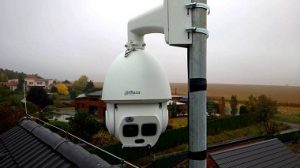
Pan/tilt/zoom (PTZ) camera solutions have long been considered staples of the video security and surveillance industry; however, new technology advancements have sparked a renewed interest in deploying them in many security applications. The new technology utilized in PTZ cameras has made the devices smaller and smarter than their predecessors, and the use of more deeply integrated mechanical components has even made them lighter in weight.
Thanks to technological advancements, high-quality PTZ camera positioning systems are a great option for your customers to secure and monitor large areas – both indoors and out. These systems can be applied to an almost limitless variety of situations where clear, accurate and responsive video surveillance is needed to efficiently and effectively cover large areas with a single camera, including applications ranging from casinos, malls, airports and stadiums to traffic monitoring, border patrol, city surveillance, critical infrastructure and homeland security operations.
Choosing the right PTZ system for a customer depends on their security needs. Most manufacturers offer a range of PTZ dome systems for outdoor and environmental use. Model types include sealed, pressurized systems that protect from water, marine salt, smoke, dust, and the finest of particulates. Also, there are hyper-sealed, stainless-steel “explosion-proof” dome systems designed to ensure the dome itself is never the source of ignition within explosive or gaseous environments, present in many industrial applications such as the petroleum industry.
PTZ systems are incorporating video analytics, which offer customers a number of benefits, including:
• Directional behaviors, which notify operators or activate cameras when someone or something moves against the designated flow of traffic, such as someone trying to walk into an exit path;
• Abandoned object behavior, which enables the video system to alert security personnel when an object – such as a backpack, box or briefcase – is set down and left unattended;
• License plate recognition, facial detection, perimeter detection and related analytics; and
• Tripwire behaviors that can activate a camera (or trigger alarms and other operations) when a person or object moves into a restricted area.
Auto-tracking for PTZs is one of the most valuable features that your customer can employ. Auto-tracking controls the PTZ actions of a camera to automatically track an object in motion and to keep it in the field of view. The tracking action can be triggered manually or automatically by defined rules, and once a rule is triggered, the camera can zoom in and track the defined target automatically. This analytic behavior takes advantage of the unique capabilities of a PTZ system, and becomes a force multiplier for the security operator.
Advanced video compression is yet another technology that has enabled PTZ cameras to regain their place in deployments. The H.265 compression standard allows for much higher compression ratios with lower bandwidth and storage requirements than previous algorithms, providing end-users with higher resolution images and deeper systems integration.
Smart H.265+, for example, is an optimized implementation of the H.265 codec that uses a scene-adaptive encoding strategy, dynamic GOP, dynamic ROI, flexible multi-frame reference structure and intelligent noise reduction to deliver high-quality video without straining the network. The technology reduces bit rate and storage requirements by up to 30 percent when compared to standard H.265 video compression.
Another option available for PTZ systems is the ability to transport high-definition video over coax. This connectivity option enables legacy coax systems to be easily upgraded to HD video using existing analog infrastructure. With HD video over coax, there is no latency in system responsiveness, and no video compression, so the images maintain a high level of detail without stretching or distortion. Because the coaxial cable allows for bidirectional data transfer, you do not need to install a separate cable to control the PTZ mechanism.
Further, the cost savings realized by retaining existing coaxial infrastructure makes HD over coax an attractive option for those looking to economically upgrade their PTZ cameras
Another advanced feature of PTZ dome systems is the integration of infrared (IR) illumination. This enables infrared light to be applied only where needed. Some dome systems have an array of three distinct areas of infrared illuminators – each with a different angle of dispersion for the IR light: wide angle, telephoto and an interim angle.
As the operator optically zooms in from wide angle to telephoto, IR illuminator LEDs will turn on and off to provide effective illumination. Additionally, when the camera is in zoom mode is modulates the infrared illumination so the system is not flooding the entire 120-degree view. The system simply adjusts to illuminate just the area in view, reducing the amount of power required.
When researching and specifying a PTZ system for your customer, keep in mind that a higher zoom factor does not necessarily equate to a better video image. Instead, the focal length of the lens will provide a better indication of what is appropriate for an application vs. comparing the zoom factor.
It is also important to communicate to your customer that not all lower domes – the clear protective housing at the bottom of a PTZ camera – are the same. Many manufacturers use a plastic lower globe to protect the camera and optics. Unfortunately, a plastic lower globe can offer a lower degree of optical clarity than glass. A plastic option may look optically clear and free of anomalies, but as the camera pans up toward the horizon, the camera begins to view through the globe in the areas where it has the least uniformity. This lack of uniformity is where most optical distortions can occur.
Some manufacturers are making use of glass lower globes, which are more optically pure and consistent than plastic globes. Some companies offer PTZ products that use a flat piece of glass to protect the optics, instead of a globe. Clear, consistent, optical-quality glass coverings enable dome systems to feature higher resolution sensors and longer optical zooms. Additionally, some dome systems provide a modified lower dome design that allows for above-the-horizon viewing. This is an excellent feature for an end-user who needs to monitor rough terrain or scenes on different planes of view.
Courtesy: Dahua Technology USA











